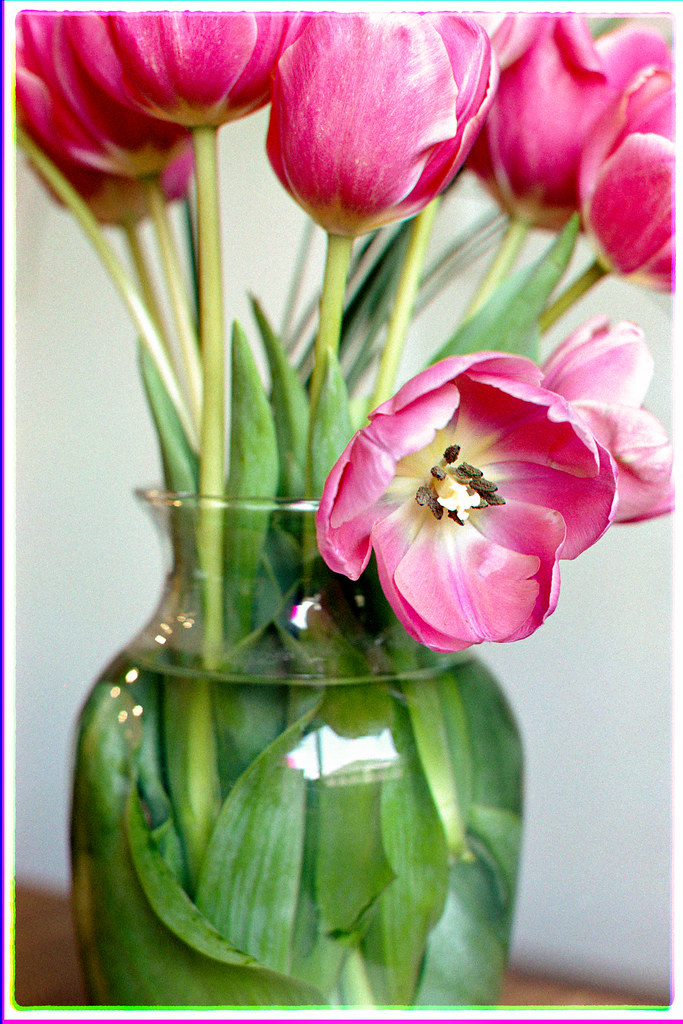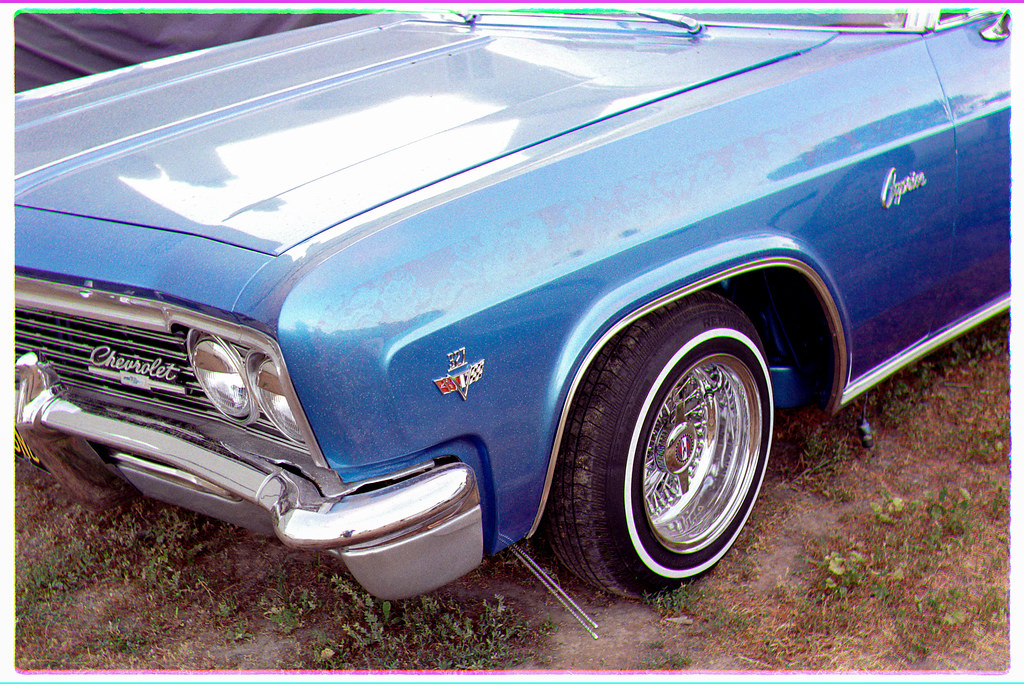dourbalistar
Buy more film
Spectacularly good results, dourbalistar - those colors look so pure and clean!
Thank you, Pál_K, much appreciated!
I'll see how I get on with GIMP. I suspect my lack of technological knowhow will be the main issue!
I had no prior experience with GIMP (or Photoshop for that matter) but the instructions I followed are very good. I'm no expert, but happy to share my process if you have questions.
dourbalistar
Buy more film
I think this is my best result so far. 
Nikon FM2n, AI Nikkor 50mm f/1.8S, Ultrafine Xtreme 400, developed in LegacyPro L110 at 1:31 for 5.5 minutes. Three individual black and white frames shot through Tiffen #25 Red, #58 Green, and #47 Blue filters, respectively, then combined using GIMP to create a trichrome color image.

2020.05.09 Roll #244-04727-positive-trichrome.jpg by dourbalistar, on Flickr
Nikon FM2n, AI Nikkor 50mm f/1.8S, Ultrafine Xtreme 400, developed in LegacyPro L110 at 1:31 for 5.5 minutes. Three individual black and white frames shot through Tiffen #25 Red, #58 Green, and #47 Blue filters, respectively, then combined using GIMP to create a trichrome color image.

2020.05.09 Roll #244-04727-positive-trichrome.jpg by dourbalistar, on Flickr
Pál_K
Cameras. I has it.
That's amazing. Color is perfect.
dourbalistar
Buy more film
That's amazing. Color is perfect.
Thank you, Pál_K! I'm very happy with how this one turned out.
dourbalistar
Buy more film
Nikon FM2n, AI Nikkor 50mm f/1.8S, Ultrafine eXtreme 400, developed in LegacyPro L110 at 1:31 for 5.5 minutes. Three individual black and white frames shot through Tiffen #25 Red, #58 Green, and #47 Blue filters, respectively, then combined using GIMP to create a trichrome color image.

2020.05.09 Roll #244-04730-positive-trichrome.jpg by dourbalistar, on Flickr

2020.05.09 Roll #244-04730-positive-trichrome.jpg by dourbalistar, on Flickr
dourbalistar
Buy more film
Nikon FM2n, AI Nikkor 50mm f/1.8S, Ultrafine eXtreme 400, developed in LegacyPro L110 at 1:31 for 5.5 minutes. Three individual black and white frames shot through Tiffen #25 Red, #58 Green, and #47 Blue filters, respectively, then combined using GIMP to create a trichrome color image.

2020.05.09 Roll #244-04734-positive-trichrome.jpg by dourbalistar, on Flickr

2020.05.09 Roll #244-04734-positive-trichrome.jpg by dourbalistar, on Flickr
tbhv55
Well-known
Nikon FM2n, AI Nikkor 50mm f/1.8S, Ultrafine eXtreme 400, developed in LegacyPro L110 at 1:31 for 5.5 minutes. Three individual black and white frames shot through Tiffen #25 Red, #58 Green, and #47 Blue filters, respectively, then combined using GIMP to create a trichrome color image.
I haven't dropped into this thread for a little while, @dourbalistar... I see that you've been getting more really excellent results. Great stuff - keep at it!
dourbalistar
Buy more film
I haven't dropped into this thread for a little while, @dourbalistar... I see that you've been getting more really excellent results. Great stuff - keep at it!
Thank you! Ran out of steam for a bit, but looking to get back to making a few more attempts.
dourbalistar
Buy more film
Some roses from our front yard.
Nikon FM2n, AI Nikkor 50mm f/1.8S, Kentmere Pan 400, developed in LegacyPro L110 at 1:31 for 5.5 minutes. Three individual black and white frames shot through Tiffen 25 Red, 58 Green, and 47 Blue filters, respectively, then combined using GIMP to create a trichrome color image.

2020.05.09 Roll #244-04738-positive-trichrome.jpg by dourbalistar, on Flickr
Nikon FM2n, AI Nikkor 50mm f/1.8S, Kentmere Pan 400, developed in LegacyPro L110 at 1:31 for 5.5 minutes. Three individual black and white frames shot through Tiffen 25 Red, 58 Green, and 47 Blue filters, respectively, then combined using GIMP to create a trichrome color image.

2020.05.09 Roll #244-04738-positive-trichrome.jpg by dourbalistar, on Flickr
tbhv55
Well-known
Very nice, @dourbalistar! You've mastered this technique. I doubt anyone could tell that this wasn't taken as a colour photograph.
Edit: The only clue that it offers is that (IMO) the colour density is slightly better than a colour photograph.
Edit: The only clue that it offers is that (IMO) the colour density is slightly better than a colour photograph.
Dralowid
Michael
As a student I worked for a couple of days with a pack shot photographer just off the Earls Court Road.
He was doing in camera separations using a 5 x 4 studio camera, filters etc. At the time it was cheaper than having a repro house do separations and b/w film and processing was of course much cheaper too. I remember it being important that the image on the negs was the correct size for print.
He was doing in camera separations using a 5 x 4 studio camera, filters etc. At the time it was cheaper than having a repro house do separations and b/w film and processing was of course much cheaper too. I remember it being important that the image on the negs was the correct size for print.
dourbalistar
Buy more film
Very nice, @dourbalistar! You've mastered this technique. I doubt anyone could tell that this wasn't taken as a colour photograph.
Edit: The only clue that it offers is that (IMO) the colour density is slightly better than a colour photograph.
tbhv55, thank you, that's much too kind of you. These are among my first attempts, so I can hardly say that I've mastered the technique.
dourbalistar
Buy more film
A total eclipse of the filters... 
1st Generation Mitsubishi Eclipse / Eagle Talon / Plymouth Laser (1990-1994).
Nikon FM2n, AI Nikkor 50mm f/1.8S, Ultrafine eXtreme 400, developed in LegacyPro L110 at 1:31 for 5.5 minutes. Three individual black and white frames shot through Tiffen #25 Red, #58 Green, and #47 Blue filters, respectively, then combined using GIMP to create a trichrome color image.

2020.05.14 Roll #245-04793-positive-trichrome.jpg by dourbalistar, on Flickr
1st Generation Mitsubishi Eclipse / Eagle Talon / Plymouth Laser (1990-1994).
Nikon FM2n, AI Nikkor 50mm f/1.8S, Ultrafine eXtreme 400, developed in LegacyPro L110 at 1:31 for 5.5 minutes. Three individual black and white frames shot through Tiffen #25 Red, #58 Green, and #47 Blue filters, respectively, then combined using GIMP to create a trichrome color image.

2020.05.14 Roll #245-04793-positive-trichrome.jpg by dourbalistar, on Flickr
dourbalistar
Buy more film
Nikon FM2n, AI Nikkor 50mm f/1.8S, Ultrafine eXtreme 400, developed in LegacyPro L110 at 1:31 for 5.5 minutes. Three individual black and white frames shot through Tiffen #25 Red, #58 Green, and #47 Blue filters, respectively, then combined using GIMP to create a trichrome color image.

2020.05.14 Roll #245-04796-positive-trichrome.jpg by dourbalistar, on Flickr

2020.05.14 Roll #245-04796-positive-trichrome.jpg by dourbalistar, on Flickr
dourbalistar
Buy more film
1966 Chevrolet Caprice.
Nikon FM2n, AI Nikkor 50mm f/1.8S, Ultrafine eXtreme 400, developed in LegacyPro L110 at 1:31 for 5.5 minutes. Three individual black and white frames shot through Tiffen #25 Red, #58 Green, and #47 Blue filters, respectively, then combined using GIMP to create a trichrome color image.

2020.05.14 Roll #245-04799-positive-trichrome.jpg by dourbalistar, on Flickr
Nikon FM2n, AI Nikkor 50mm f/1.8S, Ultrafine eXtreme 400, developed in LegacyPro L110 at 1:31 for 5.5 minutes. Three individual black and white frames shot through Tiffen #25 Red, #58 Green, and #47 Blue filters, respectively, then combined using GIMP to create a trichrome color image.

2020.05.14 Roll #245-04799-positive-trichrome.jpg by dourbalistar, on Flickr
dourbalistar
Buy more film
Nikon FM2n, AI Nikkor 50mm f/1.8S, Ultrafine eXtreme 400, developed in LegacyPro L110 at 1:31 for 5.5 minutes. Three individual black and white frames shot through Tiffen #25 Red, #58 Green, and #47 Blue filters, respectively, then combined using GIMP to create a trichrome color image.

2020.05.14 Roll #245-04802-positive-trichrome.jpg by dourbalistar, on Flickr

2020.05.14 Roll #245-04802-positive-trichrome.jpg by dourbalistar, on Flickr
dourbalistar
Buy more film
Nikon FM2n, AI Nikkor 50mm f/1.8S, Ultrafine eXtreme 400, developed in LegacyPro L110 at 1:31 for 5.5 minutes. Three individual black and white frames shot through Tiffen #25 Red, #58 Green, and #47 Blue filters, respectively, then combined using GIMP to create a trichrome color image.

2020.05.14 Roll #245-04808-positive-trichrome.jpg by dourbalistar, on Flickr

2020.05.14 Roll #245-04808-positive-trichrome.jpg by dourbalistar, on Flickr
Peter Jennings
Well-known
When I see these pics, I can’t help but wonder if this effect could be replicated purely through software. I’d never want to shoot color film again! But I don’t know anything about software.
tbhv55
Well-known
When I see these pics, I can’t help but wonder if this effect could be replicated purely through software.
Yes, it can be done in very easily in Photoshop, using the merge channels function.
My guess is that it's also possible using Gimp. That program has a reputation for being a powerful tool, but I know very little about using it.
Peter Jennings
Well-known
Yes, it can be done in very easily in Photoshop, using the merge channels function.
My guess is that it's also possible using Gimp. That program has a reputation for being a powerful tool, but I know very little about using it.
But is that without using three images shot through three colored filters? That was what I was really wondering about. Specifically, could software replicate the three-color filter effects using a single b&w negative?
Share:
-
This site uses cookies to help personalise content, tailor your experience and to keep you logged in if you register.
By continuing to use this site, you are consenting to our use of cookies.

